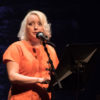Like a great jazz solo, the history of the saxophone goes all over the map.
It starts in 19th century France. When a Belgium-born, Paris-based instrument-maker named Antoine-Joseph “Adolphe” Sax got an idea for a super-instrument. It’d have the powerful volume of a brass horn, but you’d be able to play it fast and nimbly, like a woodwind. Soon, he’d worked up a prototype: A kind of mutant offspring of a clarinet and a French horn.
Sax dreamed of classical orchestras adopting his invention. But they generally found the sax sound too quote “imprecise.” Instead, saxes made their first big splash in French military bands — where their loudness was much appreciated. Later, musicians on the vaudeville circuit took a shine to the instrument. Because among other things… you could make it sound pretty silly.
It wasn’t ’til the ’20s that New Orleans musician Sidney Bechet made the sax a jazz standard. A clarinetist, he was sick of his instrument getting drowned out by louder coronets in ensembles. So when when he came across a soprano sax while on tour in London? He knew he’d found his weapon.
Bechet’s soulful sax sound caught audience’s imaginations. Big bands started making room for show-stopping sax solos. And by the time bebop jazz rolled around, sax players were frontmen. Making sounds the instrument’s inventor never imagined.
John Coltrane once described his own style as, “Starting in the middle of a sentence, and moving in both directions at once.”
The Brass Bell Martini

Forged by Mike Miles of Miles Lab in Elkhart, Indiana, where a company called Conn Instruments was the first in America to manufacture saxophones, back in the 1880s.
Ingredients:
- 1 ounce Cognac
- 1 ounce citrus vodka
- 1/2 ounce simple syrup
- 1/2 ounce fresh orange juice
Instructions:
Combine ingredients in a shaker, pour into a chilled martini glass (shaped not unlike the “bell” portion of a sax) and enjoy the brassy color and citrus taste.
[Ed. Note: This article originally referred to Adolphe Sax as “a Parisian,” but has been updated to clarify his Belgian roots.]


